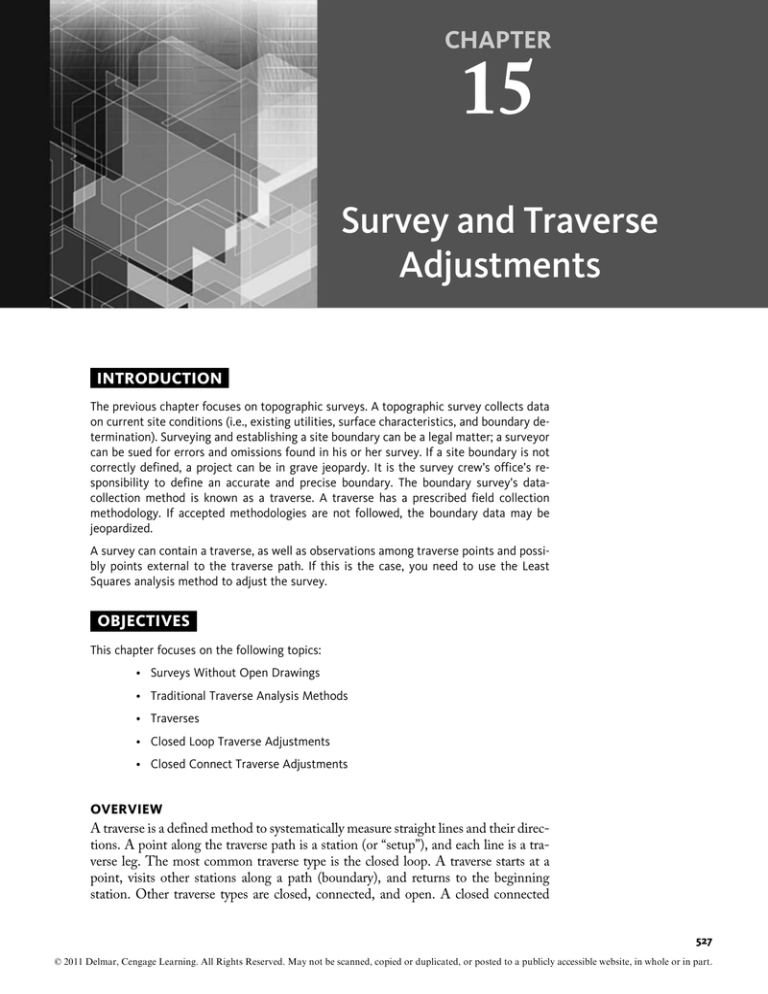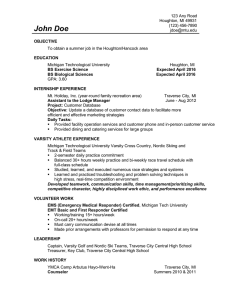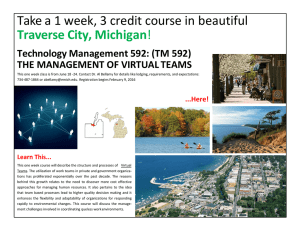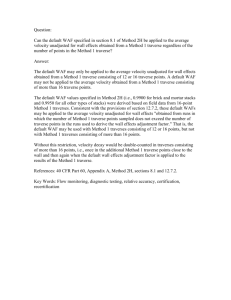
CHAPTER
15
Survey and Traverse
Adjustments
INTRODUCTION
The previous chapter focuses on topographic surveys. A topographic survey collects data
on current site conditions (i.e., existing utilities, surface characteristics, and boundary determination). Surveying and establishing a site boundary can be a legal matter; a surveyor
can be sued for errors and omissions found in his or her survey. If a site boundary is not
correctly defined, a project can be in grave jeopardy. It is the survey crew’s office’s responsibility to define an accurate and precise boundary. The boundary survey’s datacollection method is known as a traverse. A traverse has a prescribed field collection
methodology. If accepted methodologies are not followed, the boundary data may be
jeopardized.
A survey can contain a traverse, as well as observations among traverse points and possibly points external to the traverse path. If this is the case, you need to use the Least
Squares analysis method to adjust the survey.
OBJECTIVES
This chapter focuses on the following topics:
• Surveys Without Open Drawings
• Traditional Traverse Analysis Methods
• Traverses
• Closed Loop Traverse Adjustments
• Closed Connect Traverse Adjustments
OVERVIEW
A traverse is a defined method to systematically measure straight lines and their directions. A point along the traverse path is a station (or “setup”), and each line is a traverse leg. The most common traverse type is the closed loop. A traverse starts at a
point, visits other stations along a path (boundary), and returns to the beginning
station. Other traverse types are closed, connected, and open. A closed connected
527
© 2011 Delmar, Cengage Learning. All Rights Reserved. May not be scanned, copied or duplicated, or posted to a publicly accessible website, in whole or in part.
528
Harnessing AutoCAD Civil 3D 2011
traverse starts at a known point or at known points and ends at a known point or
points. The last type of traverse is an open traverse. This traverse starts at a known
point, but it ends at an observed point. An open traverse’s only known point(s) is its
starting station and possibly the backsight. An open traverse is the least desirable traverse type.
Traverse methodology starts with a beginning station and observes the next point to
be occupied as a foresight. When the foresighted point (a station) is occupied, the
field crew observes the last occupied point as a backsight. This continues around the
loop until the crew returns to the beginning point. This method creates redundant
observation data—looking forward to the next occupied point and looking back to
the last point occupied.
A traverse has three traditional adjustment methods. The first and most accepted
method is the Compass Rule adjustment. The Compass Rule adjustment assumes
that both the observed angles and the distances are in error. Another method, the
Transit Rule adjustment, assumes that the greatest amount of error is in the distances
of the traverse. The Crandall Rule adjustment assumes that there are errors in distance measurements and distributes an angular error throughout the traverse.
As a final method, users can use the Least Squares adjustment on the traverse data
because a traverse has redundant observations (forward and backward) along the traverse course. A Least Squares adjustment attempts to find the least amount of error
for all observed traverse points.
A traverse can be transcribed from a written survey journal to a field book or can be
entered in the survey Traverse Editor. Users can then export a field book containing
the observation data and thus preserve the traverse, should something happen to the
application.
Users can also record a traverse in a survey. Many times, a traverse starts a survey.
When the field book is imported, it contains the traverse, as well as all of the control
points, stations, and survey points of the overall survey. A traverse can span several
field books, as long as the field crew follows the prescribed traverse observation methods. When all of the field books are imported, the observation database represents an
overall collection of survey data. To do this, the user must toggle off the Reset network in the Import Field Book dialog box.
Unit 1
The first unit transcribes a manual survey using the Traverse Editor. The editor anticipates the data collected for the traverse and allows easy access to the data for editing errors. This unit will review the results of several adjustment methods.
Unit 2
The second unit uses a traverse within a survey—a closed loop survey. The traverse
noted by the surveyor is not found, and this unit’s task is to identify what has happened in the survey. After the problem has been determined and corrected, this unit
will review the results of several adjustment methods.
Unit 3
The third unit looks into the closed connected traverse. This traverse type starts with
known points and ends at known points. The question is, do the observation errors in
© 2011 Delmar, Cengage Learning. All Rights Reserved. May not be scanned, copied or duplicated, or posted to a publicly accessible website, in whole or in part.
Chapter 15 • Survey and Traverse Adjustments
529
the traverse affect the known ending points? This traverse has redundant and outsideof-traverse observations.
UNIT 1: THE TRAVERSE EDITOR
To use the traverse editor, users must have a local survey database. Users define a local
survey database as a part of a project or as a local folder. When a Vault project is created, it also creates a survey database with the same name as the project. When the
survey database is a part of vault, the user must check in and out the survey to work
with its data. When not using vault, all the user has to do is create the local survey
database.
After a local survey database is created, a defined network is necessary. A network is a
survey container. To start a traverse, there must be an initial station and backsight
point. The initial station must be a control point. Users define control points in the
named network that holds the traverse data. The backsight can be a second control
point or a direction. When using a direction, the user uses the control point as the
first point, types a dummy number for the second point, and enters a direction to
the dummy backsight point number.
With these preliminaries finished, it is time to define a traverse and assign it the initial station and backsight points.
LOCAL SURVEY DATABASE SETTINGS
Local Survey Database Settings contain traverse values that directly affect manual
survey entries. It is easier to set the correct data types for the survey by entering the
data in the Traverse Editor (see Figure 15.2). The settings in Figure 15.1 are for a
horizontal traverse. These settings change what the Traverse Editor expects as data.
If you are entering a survey, this survey settings section needs your attention. The
Units section sets the format for angle entry. The default is the surveyor’s shorthand
entry, that is, decimal degrees (ddd.mmss). In this format, the “mm” and “ss” are the
minutes and seconds values and cannot exceed 59 minutes or seconds.
FIGURE 15.1
© 2011 Delmar, Cengage Learning. All Rights Reserved. May not be scanned, copied or duplicated, or posted to a publicly accessible website, in whole or in part.
530
Harnessing AutoCAD Civil 3D 2011
TRAVERSE EDITOR
Users enter a manual traverse or review its data in the Traverse Editor (see Figure
15.2). When the data is floating, one side of the editor displays the station data and
its backsight. The other side lists each traverse station and its observations. The editor
displays only the traverse stations and their observations; no sideshots are shown.
A traditional traverse does not use or acknowledge cross-traverse or outside-oftraverse observations.
FIGURE 15.2
If you are manually entering traverse data, you first must define it (i.e., give it a name
and a description). After you define the loop, you next enter the traverse data. The
starting station and backsight points are entered in the New Traverse dialog box
(see Figure 15.3).
© 2011 Delmar, Cengage Learning. All Rights Reserved. May not be scanned, copied or duplicated, or posted to a publicly accessible website, in whole or in part.
Chapter 15 • Survey and Traverse Adjustments
531
FIGURE 15.3
You modify a traverse definition in the Traverse Manager (see Figure 15.4). When
you select a traverse and press the right mouse button, a shortcut menu displays with a
list of appropriate commands.
FIGURE 15.4
© 2011 Delmar, Cengage Learning. All Rights Reserved. May not be scanned, copied or duplicated, or posted to a publicly accessible website, in whole or in part.
532
Harnessing AutoCAD Civil 3D 2011
The editor assumes that the first foresight entry for a station is the point number of
the next forward station. Then, using the traverse data, the user enters the remaining
stations and observations.
When you are using the Traverse Editor to evaluate a defined traverse, all of the stations listed in its definition fill in the station and observation values. The editor is the
easiest place to identify where a traverse may be broken (due to insufficient data or an
absence of data).
SURVEY AND VAULT
You need to define the project first when you are using Vault with a survey because
defining a project also defines a survey database. When you view the Survey panel,
you will see that the Local Survey has two icons: one for a project-controlled survey
(a pick and shovel) and one for when it is locked (a pencil with a circle slash).
To unlock and use the survey folders, you must check out the survey from Vault. To
check out a project’s survey, you must go to Prospector’s Master View project area,
select the Survey heading (it must have a white circular icon), press the right mouse
button, and select Check out from the shortcut menu. A white circular icon indicates
that the survey is available for check out. If someone else has the survey checked out
(shown by a white circle with a checkmark), you must contact that person to have him
or her relinquish the check out. If you edit and change any files, you may jeopardize
the survey’s quality. You may overwrite someone else’s efforts when you try to check
in work.
The Vault survey folder is the current project working folder set in the Prospector
Projects area.
EQUIPMENT LIBRARY
Users should have at least one equipment definition that is general enough to describe
the errors in most instruments used for surveys. There should be one entry for each
instrument used for surveys and traverses. Civil 3D Survey uses the instrument’s entry
in the library to calculate observation errors (see Figure 15.5).
© 2011 Delmar, Cengage Learning. All Rights Reserved. May not be scanned, copied or duplicated, or posted to a publicly accessible website, in whole or in part.
Chapter 15 • Survey and Traverse Adjustments
533
FIGURE 15.5
SUMMARY
• All traverses must have at least one control point and a backsight.
• A backsight can be a second control point or a dummy point with an azimuth or
bearing to it from the first station.
• The Measurement Type Defaults under the Local Survey Database settings
directly affect what values the Traverse Editor expects while you are entering
traverse data.
• The Traverse Editor uses the first entry for an ahead station as the next forward
point in the traverse.
• Users can preview the adjustment values by toggling off Update Survey Database in the Traverse Analysis dialog box.
The next unit works with a topographic survey that contains a traverse.
UNIT 2: SURVEY WITH A TRAVERSE
Many times, a traverse is a part of an overall survey. The field crew should record in a
journal (also known as the field book) the traverse, its point numbers, and a drawing
that represents the traverse loop. The crew should keep track of point numbers and
their descriptions. However, sometimes things do not go correctly, or the crew does
not know that the observations have not been done as noted. Civil 3D Survey tools
help identify what may be wrong or where a survey breaks down. The Edit
© 2011 Delmar, Cengage Learning. All Rights Reserved. May not be scanned, copied or duplicated, or posted to a publicly accessible website, in whole or in part.
534
Harnessing AutoCAD Civil 3D 2011
Observations and Traverse Editor are the two best places to identify issues with survey and/or traverse data.
The next exercise is such a survey. The field crew has a sketch in the journal that describes the traverse. However, when defining the traverse, an error message appears
that states there is not enough data for the traverse analysis.
There are two ways to discover this error’s cause, and both take time to rummage
through the survey’s setups and data. By knowing what a traverse is and what data it
needs, users can review a setup and look for the necessary data and move on. If the
necessary data is not in a setup, this is where the traverse breaks. Once the break is
discovered, there is the issue of whether to continue the traverse or not. If no data is
present or there is data that supports an alternate traverse definition, the user should
consult with the surveyor about the errors and options.
SUMMARY
• The Traverse Editor is the best place to discover where a traverse is broken.
• Observations listed in the Traverse Editor relate only to the current traverse
definition.
• When you are reviewing a station’s complete observations, go to the Network’s
Setup list and review its values in Edit Observations.
The next unit reviews a second traverse type, the closed connected traverse.
UNIT 3: CLOSED CONNECTED SURVEY
What happens when the beginning and ending points of a survey are known coordinates? Does the Least Squares analysis method adjust these ending points even if they
have known coordinates? How does Civil 3D Survey handle survey errors when it
observes these known ending coordinates? Each question is legitimate. Points with
known coordinates, even if they are observed with errors, remain at their original coordinates. These points are treated as control points even if they are a part of the survey observations. Observation errors place the points at a different set of coordinates,
and the observations are adjusted to keep the points at their known coordinates at the
survey’s end.
Any external or redundant cross-traverse observations are ignored in traverse analysis.
These methods analyze only traditional traverse data. To analyze a survey that contains additional observation data, users have to use the network Least Squares
analysis.
SUMMARY
• Traditional traverses use only foresight and backsight data.
• When adjusting a traverse by the Least Squares method, you cannot review the
Least Squares input file.
• A survey containing a traverse with cross-traverse observations or outsideof-traverse observations must be analyzed by the Least Squares at the network
level.
© 2011 Delmar, Cengage Learning. All Rights Reserved. May not be scanned, copied or duplicated, or posted to a publicly accessible website, in whole or in part.




